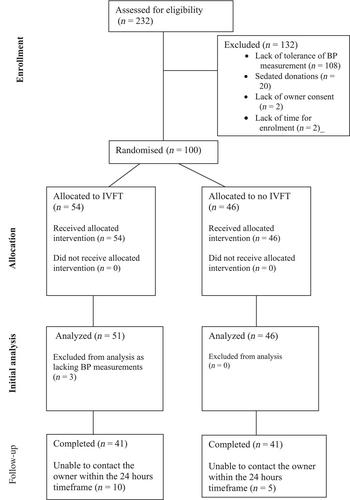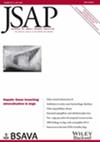Intravenous fluid therapy compared to no treatment following blood donation in cats: a randomised controlled trial
Abstract
Objectives
There is currently no consensus regarding the use of intravenous fluid therapy in feline patients post-blood donation in veterinary medicine. The primary aim of this study was to determine whether blood donation can be performed safely without post-donation intravenous fluid therapy. The secondary aim was to report owner-noted post-donation changes.
Materials and Methods
The study aimed to enrol 100 conscious feline blood donations by client-owned cats performed at a veterinary teaching hospital. Donors were randomised to either receive intravenous compound sodium lactate (twice the volume of blood donated over 2 hours) immediately after blood donation, or to receive no post-blood donation intravenous fluid therapy. Systolic blood pressure was measured non-invasively at 0, 60 and 120 minutes post-donation. Median blood pressures were compared between the two groups using a Shapiro-Wilk test. Owners were called the day following the donation to collect information on changes in their cat post-donation.
Results
One hundred cats were enrolled and the data of 97 cats were analysed; 46 who received intravenous fluid therapy and 51 who did not. Mean donation volume was 9.95 mL/kg for the intravenous fluid therapy group and 9.72 mL/kg for the non-intravenous fluid therapy group. At each time point, the median blood pressure did not differ significantly between the two groups. The main reported changes in both goups were bruising at the venepuncture site with 27.3% (12/44) in the IVFT group and 23.4% (9/37) in the no-IVFT group, and mild lethargy up to a maximum of 24 hours post donation with 11.4% (5/44) in the IVFT group and 18.9% (7/37) in the no-IVFT group.
Clinical Significance
This study suggests that the use of intravenous fluid therapy post-feline blood donation may not be necessary. This could mean reduced hospitalisation time for feline donors, possibly decreasing feline stress.


 求助内容:
求助内容: 应助结果提醒方式:
应助结果提醒方式:


